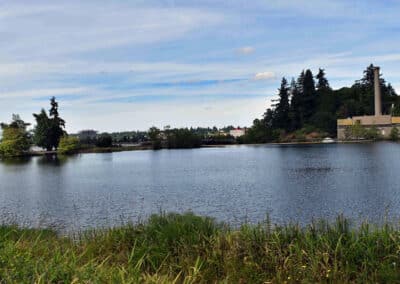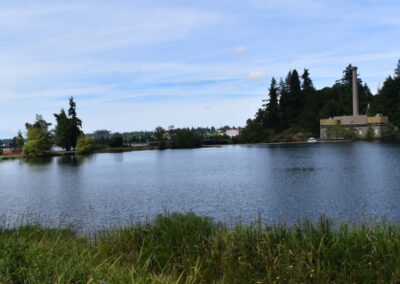TMDLs Cleaning Up Water Pollution
Cleaning Polluted Waters
Pollution Clean-up Plans (“TMDLs”)
What Triggers the Development of a TMDL Clean-Up Plan?
After a state identifies waters that violate water quality standards, it is required to develop science-based clean-up plans for those waters called “Total Maximum Daily Loads” (TMDL). A TMDL generally applies to a specific waterbody and specific pollutant although some are done at a watershed or even basin scale in order to take account of the cumulative pollution inputs across large landscapes. States are required to work off their very long—and rapidly growing—lists of impaired waters because those waters are, by definition, violating water quality standards that define what it means to protect public health and species. The law requires that states establish priorities but, in reality, the states tend to develop the most TMDLs for pollutants they get comfortable with. For example, Oregon has issued far more TMDLs for temperature pollution than any other pollutant. And Washington has issued far more TMDLs for bacteria pollution (an indicator of human pathogens) than other pollutants.
Both states tend to avoid developing TMDLs that will result in required limits in discharge permits, preferring to focus on TMDLs that apply to largely unregulated nonpoint sources of polluted runoff. However, the development of a TMDL does not create any new legal basis to control nonpoint sources, which makes the development of these TMDLs fairly pointless. But the states like to create a myth that TMDLs result in water quality improvements. For example, Washington state likes to say that TMDLs are fundamental to its nonpoint source program even as it admits that TMDLs don’t help control polluted runoff at all. The development of a TMDL does not magically confer political will on the state to do something that it doesn’t want to do in the first place, namely control nonpoint sources such as logging and farming.
How Does a TMDL Work?
A TMDL first determines how much of a pollutant can be allowed into a waterbody each day given that the safety of a pollutant in water quality standards is generally calculated as a concentration. This total is called the water’s “loading capacity.” For example, a TMDL for dioxin discharged to the entire Columbia River Basin determined that not more than about the size of two aspirin tablets of dioxin could enter the system without causing a violation of water quality standards, which allow 0.013 parts per quadrillion in the water. For other pollutants, a daily load would be measured in pounds or tons. Much of this work is done by developing a model of how the waterbody works and then using the model to establish the total loading of one or more pollutants that affect water quality.
Many water quality problems are caused by multiple impacts. For example, temperature is affected by the amount of flow in a stream, the amount of shade cast by stream-side trees, and whether sediment has made the stream unnaturally shallow and wide (which makes it heat up faster). Likewise, depletion of dissolved oxygen is a function of nutrient pollution and conditions (such as temperature and low flows) that cause those nutrients to stimulate the growth of algae that, when it dies, sucks oxygen out of the water. But oxygen may also be removed by chemical processes in which forms of nitrogen use oxygen as they are transformed (such as from ammonia to nitrate).
After determining that daily load, the TMDL must allocate responsibilities for cleaning up the excess pollution. If coming up with the daily load is like making a pie of a certain size (the aspirin tablet in the dioxin example), the allocation is like cutting the pie and handing around the pieces. Pollution sources that get a big piece may have to do a lot less to clean up their pollution than those given a tiny sliver, depending on their current contribution to the problem. These allocations are then incorporated into the permits that the state issues to point source dischargers of that pollutant, assuming the state gets around to reissuing permits in a timely way. Amounts given to point sources with permits are called “wasteload allocations” and amounts given to polluted runoff from nonpoint sources are called “load allocations.” Load allocations for nonpoint sources are not generally described in ways that are useful for the public or pollution sources to understand. For example, if TMDLs gave out allocations to logging sources described as the width, height, and density of needed stream-side trees, the TMDLs would be helpful. These riparian buffers could be compared to what the state logging rules allow or what loggers are actually leaving next to streams. Instead, the states issue allocations as measurements of shade, ensuring that no apples-to-apples comparisons can be made. In this way, the development of TMDLs is a lot of science that results in little or no change in water pollution levels.
There is supposed to be a relationship between the allocations made to point sources and those made to nonpoint sources. The smaller the allocation to nonpoint sources (meaning the more pollution they must prevent from entering the water), the bigger the allocations are to dischargers regulated under permits. States such as Oregon and Washington like to pretend that nonpoint sources, such as farming and logging, will clean up a lot of their pollution. This is magical thinking because the existence of a TMDL does not improve the lack of regulation of these sources. In this way, the states violate a principle of federal law called “reasonable assurance.” States are required to demonstrate that when they allow more pollution from permitted sources it is because they have a reasonable basis for concluding that nonpoint sources will control their pollution. EPA does not stop states from grossly exaggerating their predictions of reductions in polluted runoff, and allowing permitted sources to discharge far more than is justified. In other words, TMDLs often let both point and nonpoint sources off the hook resulting in the expenditure of tax dollars for no water quality improvement purpose.
Stay Informed

Puget Sound Endangered by Agency Inaction

Comments on Deschutes River TMDL

